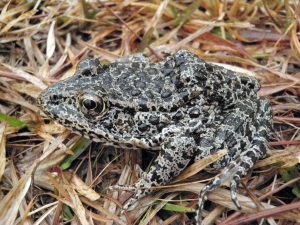On February 13, a sharply divided U.S. Court of Appeals for the Fifth Circuit , by a vote of 8 to 6, rejected a petition seeking

The Dusky Gopher Frog, once known as the Mississippi Gopher Frog, has an average length of about three inches and a stocky body with colors on its back that range from black to brown or gray and is covered with dark spots and warts. (Western Carolina University photo/ John A. Tupy)
an en banc rehearing of the court’s initial decision in the case of Markel Interests, LLC, et al., v. U.S. Fish and Wildlife Service, et al. In its June 5, 2016 decision, the Fifth Circuit held that 1500 acres of private land located in Louisiana is subject to the requirements of the Endangered Species Act (ESA) with respect to the dusky gopher frog, which was determined to be an endangered species in 2001, but whose “critical habitat” was not designated until 2012. At the present time, the species is located only in Mississippi, but the U.S. Fish and Wildlife Service (Service) designated not only several thousand acres of Mississippi land as its critical habitat, but land in Louisiana as well, reasoning that the presence of five ephemeral ponds on the Louisiana land could support the species’ reproduction. Apart from the presence of these ponds, all parties appear to agree that the Louisiana land is otherwise uninhabitable.
In 2012, the Service designated 1544 acres in Louisiana as a critical habitat of the frog although it has not been seen in Louisiana since 1965. The Service reasoned that this land contains ephemeral ponds that are essential to the species existence. However, the land is privately owned, and the landowners plan to use this land for residential and commercial development. The District Court upheld this designation, and the Fifth Circuit affirmed that decision in a holding that the dissent described as “unprecedented and sweeping.” The landowners argued that this designation of their land: (1) violates both the ESA and the Administrative Procedures Act (APA); (2) exceeds the Service’s constitutional authority under the Commerce Clause in the U.S. Constitution, and(3) violates the National Environmental Policy Act (NEPA). The Fifth Circuit held that the landowners have standing to contest the critical habitat designation, but no standing under NEPA to challenge the Service’s failure to prepare an environmental impact statement because, in this instance, they were asserting purely economic injuries and this is insufficient.
On June 30, 2016, the Fifth Circuit issued its initial ruling in this matter, involving critical habitat designations on private land. The case was decided on a 2 to 1 vote with Judge Owen providing a strong dissent. The majority was at pains to state that “critical habitat designations do not transform private land into wildlife refuges.” Nevertheless, the extension of the ESA to this private land may conceivably have federal permitting consequences later if the future development of the land triggers, for example, Clean Water Act (CWA) considerations.
The ESA envisions two types of critical habitat : those that affect occupied and unoccupied areas. The Service conducted a scientific search for the ephemeral ponds the frogs needs, and found five of them on the plaintiffs’ Louisiana property. Next, the Service had to determine whether this land could be adjudged to be “essential for the conservation of the [endangered] species.” Since that term is not defined in the ESA, and the Service has been delegated authority to make these ESA determinations, the Fifth Circuit applied Chevron deference to hold that the agency’s use of “essential” was authorized. The dissent strongly disagreed with this ruling—indeed the case may well have turned on this use of the term, “essential;” The Fifth Circuit then held that the economic calculus made by the Service was committed to agency discretion, and it was unreviewable. The landowners argued that they stood to lose several million dollars, and any economic test would find the Service’s determination unreasonable. The Commerce Clause argument failed principally because no court has ruled that the ESA, even when it affects private property, can be challenged as an unwarranted expansion of the Congress’ Commerce Clause authority. In her dissent, Judge Owen noted that the only way this species can thrive on the Louisiana land is the hope that the landowners will remove the existing pine trees and replace them with another variety more suitable for the propagation of the dusky gopher frog.
Judge Jones filed a long opinion for the dissenters to the court’s decision not to re-hear this case. She writes that the panel majority, relying on administrative deference, reasoned that (1) the ESA and the Service’s implementing regulations have no “habitability requirement,” (2) the unoccupied Louisiana land is essential to the conservation of the frog even though it contains only one of the three features the Service believes are critical to its habitat, and (3) the Service’s decision not to exclude this Louisiana tract from the critical habitat designation is judicially unreviewable. Judge Jones, after conducting a review of the provisions of the statute and its legislative history, argues that these conclusions are untenable, and in view of the importance of this case, ”illustrate the importance of further review.” Otherwise, the Service’s critical habitat designation power is “virtually limitless.” The Fifth Circuit confronted many difficult issues in resolving this dispute, and it should be very interesting to see where this case goes.
Photo: U.S. Department of Agriculture, Dusky Gopher Frog-a, Taken January 23, 2010 – Creative Commons
 Gravel2Gavel Construction & Real Estate Law Blog
Gravel2Gavel Construction & Real Estate Law Blog


